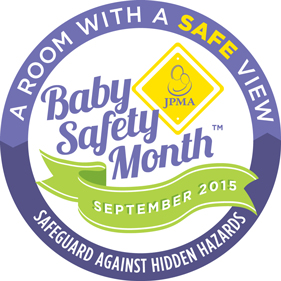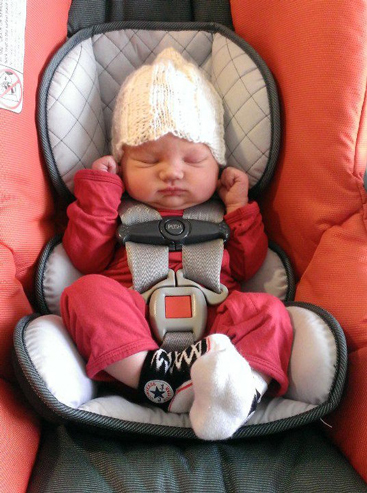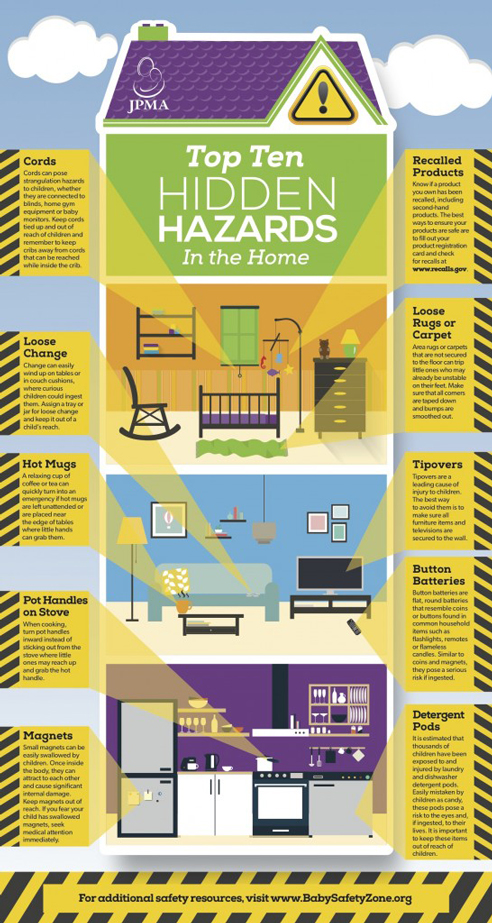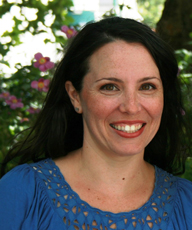September 27, 2015
The Top Ten Safety Messages to Share with New Parents - September is Baby Safety Month!
By: Sharon Muza, BS, LCCE, FACCE, CD/BDT(DONA), CLE | 0 Comments
By Jenny Burris Harvey, BA, CPST
 September is Baby Safety Month, and before the month entirely slips away, I wanted to acknowledge this and share some resources with childbirth educators that they can use in their classes. I asked colleague Jenny Burris Harvey, BA, CPST, a skilled safety educator in Seattle, WA to share the top ten safety messages that birth professionals and others can make sure parents hear or receive information on during their prenatal classes. While I acknowledge that there already is so much we want to cover during our classes, I urge educators to consider how they can pass this important information on to families. If there is absolutely no time to mention these topics in class, consider putting out an information sheet with important resources and links that you provide to the families you work with. It could save a life. - Sharon Muza, Community Manager, Science & Sensibility
September is Baby Safety Month, and before the month entirely slips away, I wanted to acknowledge this and share some resources with childbirth educators that they can use in their classes. I asked colleague Jenny Burris Harvey, BA, CPST, a skilled safety educator in Seattle, WA to share the top ten safety messages that birth professionals and others can make sure parents hear or receive information on during their prenatal classes. While I acknowledge that there already is so much we want to cover during our classes, I urge educators to consider how they can pass this important information on to families. If there is absolutely no time to mention these topics in class, consider putting out an information sheet with important resources and links that you provide to the families you work with. It could save a life. - Sharon Muza, Community Manager, Science & Sensibility
Childbirth educators often find themselves in the awkward position of having a wealth of information to share with expectant families but not enough time to share it all. As you pick and choose what to spend your time on, consider that your class may be the only class that these families take in preparation for parenthood. While the bulk of what you teach will be about pregnancy, birth, and postpartum, you may have the opportunity to incorporate some key messages about keeping those new babies safe, as well.
There's never a safe time to leave a baby in an unsafe place. Most parents and caregivers assume that they'll have at least a few months before they have to worry about having a safe place to contain their baby. They don't expect that a new baby could roll off a couch, sit up and fall from a bouncy seat, or pull loose car seat straps around their neck. They don't think about the cat jumping up on the bed being enough weight to knock the baby off or how deadly it can be to leave baby alone in the car for even a moment.
This simple message can be used in many contexts and easily incorporated into newborn care classes. It applies to holding baby, putting baby to sleep, wearing baby in a carrier, bathing baby, putting baby in a car seat, or even the logistics of getting dressed, going shopping, or any other aspect of daily life.
Here are a few other messages that, in my years of teaching, I have found to be the most valuable for new and expectant parents to hear from someone they trust.
1. Learn how to use the child's car seat correctly.
Three out of four car seats are used incorrectly, meaning they would likely not be able to protect the child in a sudden stop or crash. A properly used car seat reduces an infant's risk of injury or death by 71 percent. It's not that car seat use is rocket science, it's that it's a big, often complicated puzzle. Parents should start by reading their car seat manual and their vehicle manual. Dr. Alisa Baer (The Car Seat Lady) has great tips on how to properly put a newborn in a car seat and safely keeping baby warm in cold weather. Urge parents to practice getting the harness straps nice and snug and the chest clip up to armpit level. Finally, emphasize the value of having their car seat checked by a certified child passenger safety technician (CPST). Make note of local resources in your area or have them go to Seatcheck.org to find a fitting station near them. Consider an educational handout, such as This is the Way the Baby Rides, but be sure to keep it current.

Proper harness use on a newborn © Jenny Burris Harvey
Note: Please do not send families to any fire station, police station, or hospital without confirming that they do have a CPST who provides seat checks. If you want to learn more about child passenger safety, contact your local Safe Kids Coalition to find out about the CPS awareness classes or technician trainings nearest you.
2. Keep the child rear facing as long as possible, at least two to three years.
The safest way to ride in a vehicle is rear facing. Rear facing children are 75 percent less likely to suffer head, neck, or spinal cord injuries in a crash. Experts agree that keeping a child rear facing until they outgrow the height or weight maximum for the rear-facing mode of their convertible car seat is the safest for the child. A study from the American Academy of Pediatrics found that children are five times safer staying rear facing until age two than turning around at age one. The National Highway Traffic Safety Administration recommends staying rear facing until at least age three. What everyone agrees on is to find a car seat that allows a child to stay rear facing as long as possible.
3. Learn about sleep safety.
To protect against sudden unexpected infant deaths (SUIDs), such as sudden infant death syndrome (SIDS) and accidental suffocation, it is recommended that baby:
- Be put down on his back for sleep, every time he sleeps.
- Sleep in his own crib or safety-approved sleep area in the same room as the parents.
- Is breastfed.
- Does not get overheated by clothing, sleepers, hats, or heaters.
- Uses a dry pacifier as he falls asleep.
- Has nothing else in the sleep area with him, including blankets, pillows, toys, or sleep positioners.
Safe sleep can be difficult to remain objective about for some childbirth educators. Always offer evidence-based best practice guidelines first, then offer some help on practical trouble shooting if things don't end up working that way. Co-sleeping or bed-sharing is a controversial issue that can get heated pretty quickly. It's important to acknowledge the risks involved, as well as the likelihood that parents might find themselves resorting to it at some point just to get some sleep. Offer resources on how they can learn more about how to share a bed with their baby as safely as possible. James McKenna and La Leche League offer well-researched and easy-to-read information on the topic.
Note: There are a number of great safe sleep guides for parents and caregivers, such as those from the American Academy of Pediatrics. Be sure you have the most current information on safe sleep, too. Sign up for updates from the Safe to Sleep campaign, the Infant Sleep Information Source, and watch for webinars and other professional training updates on safe sleep.
4. Baby gadgets and gizmos cannot do a parent's job for them.
There are many baby products that claim to keep a baby safe for parents, from heating bottles to the perfect temperature to protecting them from SIDS. While these products may be tempting, it's important to know that most of them are not regulated and often offer a very false sense of security. Some products may make parents' jobs a little quicker or easier, but they cannot keep a child safe for them. Baby monitor cords have strangled babies in their crib, many "safe sleep" products have been recalled due to injury or death, and aftermarket car seat accessories can jeopardize baby's airway or their safety in a crash. Emphasize the importance of thinking through possible risks before using an unregulated product for a baby. Remind parents that nothing should replace supervision and following best practice guidelines for keeping their baby safe.
5. Falls are the leading cause of unintentional injury in the first two years of life, and most of these falls occur when the child is dropped by a caregiver.
Dropping the baby is a big fear for a lot of new parents. While we want to offer reassurance, we also need to acknowledge the validity of this fear and offer some tips for reducing the likelihood of it happening. Carrying only baby, having a good hold on the head and a hip, removing trip or fall hazards around the home, and keeping a little light on throughout the house at night are some of my favorite tips for helping parents not drop their little ones.
Babywearing is a great tool for caring for a baby who wants to be held while still giving parents some freedom to do other things. There are many different kinds of carriers, and they all have different rules and instructions. Families should make sure their carrier is safe for use with newborns and that they are able to use it correctly. Baby carrier manufacturers often provide tips and videos on proper use and Babywearing International has information online and local chapters where people can get hands-on help.
Learn more about reducing fall hazards around the home. Mounting walk-through baby gates at the top and bottom of stairs, using safety straps on baby products, using window guards, bolting furniture to walls, moving the crib mattress down before baby can sit up, and never leaving baby alone on a raised surface will all reduce the likelihood of a serious fall.
6. It's really, really stressful when a baby cries. Have a plan.
The average baby cries between one and five hours per day. Most crying is a late cue to let parents know that baby had a need that wasn't met in time. If the need is met, she'll stop crying. However, some crying will not stop, no matter how parents try to soothe their baby. This inconsolable crying often seems very severe, as if the baby is in pain. Caregivers often feel as though something is very wrong, either with their baby who won't stop crying or with themselves because they can't make it stop.
The Period of P.U.R.P.L.E. Crying offers information about inconsolable crying, including reassurance that, unless there are other symptoms or indicators, there is nothing wrong with the parents or their baby. Of particular note to new parents may be the findings that:
- Inconsolable crying peaks around two months old.
- Most babies have a regular fussy time, typically in the evenings.
- Baby's nervous system isn't fully developed, which means she can't fully control when she stops crying.
It is critical to address how difficult this is to cope with, even for loving caregivers, because it is the leading cause of abusive head trauma (Shaken Baby Syndrome). Shaken Baby Syndrome happens when the baby's head is shaken front-to-back with enough force, even just for a moment, to cause permanent damage to the baby's brain. Parents and other caregivers should have a plan for what to do when baby won't stop crying. Getting support from their family and their community can help during this hard time. Having the phone number for the Fussy Baby Network or crisis hotline within easy reach at all times is also a good idea.
7. Don't try to fix a problem before it's there.
Parents have access to so many baby products, baby care blogs and books, and parenting advice, it can be really easy to buy into the idea that they need to prevent common problems parents face before they start. "Oh, you have to get one of these baby seats because it's the only way my baby would sleep for the first three months!" can sound pretty convincing to a parent who is anxious about not getting enough sleep. Seeing a rear-view mirror that allows a parent to see baby while he's in his car seat could make a parent think that it would be dangerous to not be able to see him.
Many parents choose to do things that are potentially unsafe for their baby, based on purely good intentions, without having tried it the safest way first. Start with what is known to be the safest for the baby. If, after a good effort, that doesn't work, then think about what the next safest option to try is. Be sure to consider the risks before trying alternatives.
 8. Give the home a safety makeover.
8. Give the home a safety makeover.
Start with the basics. A home should be a safe place for the child to explore and learn about navigating the world around them. It should also be a place where parents don't have to constantly worry about the baby's safety.
Burns & Fires:
- Scalds are the leading cause of burns in infants. Turn the water heater down to 120 F, use the back burners, and don't eat, drink, or prepare hot things while holding a baby.
- Have working smoke alarms, carbon monoxide detectors, and fire extinguishers on every level of the home and outside each sleep area. Have a fire escape plan that includes a safe way to get out from the upstairs with baby.
Poisons:
- Program Poison Control 1-800-222-1222 into cell phones and call right away if there is a possibility that a child has been poisoned.
- Include cosmetics and personal care items during child proofing, as they're the leading cause of poisonings in young children.
Drowning:
- It takes as little as 2 inches of liquid for a child to drown.
- Most infants drown in the bathtub. Always have one hand on the baby in the tub.
Emergencies:
- Have first aid kits, with infant supplies, in the home, car, and diaper bag.
- Have a plan and supplies for emergencies or disasters, including supplies for baby.
Anything with potential to cause life-threatening injuries must be child-proofed. Guns, knives, poisons, pools, staircases, and other immediate threats must be locked and inaccessible. Things thatcould potentially harm a child are more of a grey area where caregivers must weigh the risk versus the inconvenience of child-proofing and decide what their comfortable level of risk is.
9. Learn CPR and Choking Rescue.
It is very unlikely that a baby will need Cardiopulmonary Resuscitation (CPR). However, if he does, it's critical that parents know what to do. Choking is a common emergency in infants and young children, so it's also important that parents are confident in performing choking rescue. Guidelines change every few years, encourage families to keep their skills current. The American Heart Association and American Red Cross offer CPR and choking rescue classes in hospitals and communities all across the U.S.
10. Slow down.
We live in a culture of multitasking. Being stressed, distracted, or in a hurry greatly increases the risk of injury for the children we care for. From baby choking because a baby is being fed too fast, to dropping baby while trying to carry too many things at once, to forgetting baby in the back seat of the car while parents are busy talking on the phone, it's dangerous to do too much at once. Slow down. Encourage parents to shift their priorities and give themselves some slack for a while. Get support when needed. A healthy, engaged parent is one of the best safety nets for a child.
While the topics may be very different than what you usually cover, the big concepts are very similar. Encourage families to educate themselves and get support so they can make informed decisions about their child's safety from the very start.
What safety information do you like to share with the parents you work with? What are your favorite resources for helping parents to learn how to keep babies safe? Share your thoughts, ideas and resources in the comments section below. - SM
References
Decina, L.E., Lococo, K.H., & Block, A.W. (2005) Misuse of child restraints: results of a workshop to review field data results. Traffic Safety Facts: Research Note. Retrieved from http://www.nhtsa.gov/people/injury/research/tsf_misusechildretraints/images/809851.pdf
Durbin, D. & COMMITTEE ON INJURY, VIOLENCE, AND POISON PREVENTION (2011). Technical report - child passenger safety. Pediatrics peds.2011-0215. doi:10.1542/peds.2011-0215
Henary, B., Sherwood, C.P., Crandall, J.R., Kent, R.W., Vaca, F.E., Arbogast, K.B., & Bull, M.J. (2007). Car safety seats for children: rear facing for best protection. Injury Prevention, 13:6 398-402. doi:10.1136/ip.2006.015115
NEISS All Injury Program operated by the Consumer Product Safety Commission (CPSC). 10 leading causes of nonfatal injury, United States, 2003-2013, all races, both sexes, disposition: all cases. National Center for Injury Prevention and Control, CDC. Retrieved from WISQARS http://www.cdc.gov/injury/wisqars/nonfatal.html
About Jenny Burris Harvey
 Jenny Burris Harvey, BA, CPST, is an educator, writer, and mom with a background in injury prevention health promotion, human development, and family support who specializes in infant injury prevention and child passenger safety. She has been supporting and educating families and professionals around child health and safety for many years, but found her passion in empowering new and expectant parents to keep their babies safe. With over ten years in the child passenger safety field, Jenny has worked and volunteered on a local, national, and federal level to educate families and professionals on proper car seat use. She also worked with Safe Ride News to create a continuing medical education module for pediatric healthcare providers. Jenny currently oversees and teaches Babysafe classes for Great Starts Birth and Family Education program at Parent Trust for Washington Children and is the co-author of the 5th edition of Baby & Me, a low-reading level book on pregnancy and newborn care.
Jenny Burris Harvey, BA, CPST, is an educator, writer, and mom with a background in injury prevention health promotion, human development, and family support who specializes in infant injury prevention and child passenger safety. She has been supporting and educating families and professionals around child health and safety for many years, but found her passion in empowering new and expectant parents to keep their babies safe. With over ten years in the child passenger safety field, Jenny has worked and volunteered on a local, national, and federal level to educate families and professionals on proper car seat use. She also worked with Safe Ride News to create a continuing medical education module for pediatric healthcare providers. Jenny currently oversees and teaches Babysafe classes for Great Starts Birth and Family Education program at Parent Trust for Washington Children and is the co-author of the 5th edition of Baby & Me, a low-reading level book on pregnancy and newborn care.
Tags
Breastfeeding Postpartum Safe sleep Baby Safety Month Babies ChidBirth Education Car Seats Jenny Burris Harvey